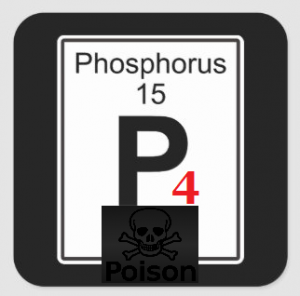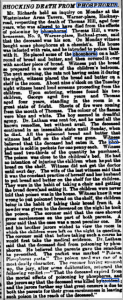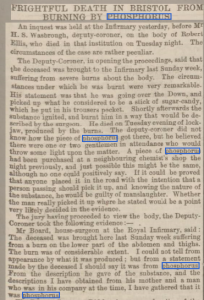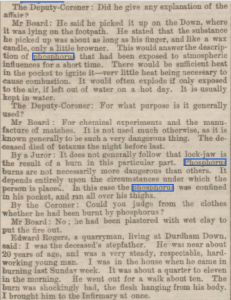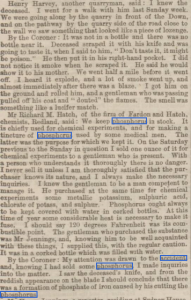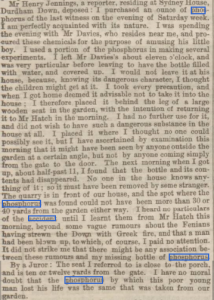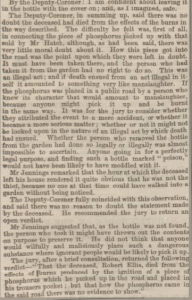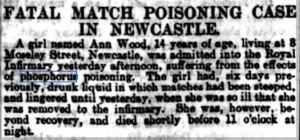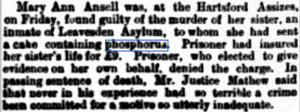The most obvious known fact about this substance in its vile unnatural elemental form is that it is a deadly poison. For this reason it was used extensively in the world of “vermin” control, as I have looked at before. It was also used in matches, before this too was eventually banned because of the phossy jaw effects that it had on those making them.
These are a few early articles from the 19th Century I have found from the newspaper archive which demonstrate the lethal potential of element 15, and why even a small amount of this chemical ended the lives of those who had the misfortune to come into contact with it by varying means. Albright and Wilson had of course by now set up their dirty producing factory at Oldbury.
From 24th August 1864 Oxfordshire Telegraph, we get the story of the death of a four year old boy, Thomas Hill who had eaten some rat poison purchased from a chemist by his father.
Bizarrely he had laced some bread and butter and placed it in his children’s bedroom! The children had taken this from a shelf and scoffed the lot 😡
His mouth set on fire and he took 5 days to die. This act of “gross carelessness” by the parents demonstrates how this substance, available cheaply and easily was being manufactured. Albright and Wilson were by now in business and producing phosphorus for this very purpose, and perhaps all those involved in the manufacture of this rat bait were as culpable as the idiot father. Incredibly it would be another 100 years before The Animal Cruel Poisons Regulations came into effect , banning this “poison of most deadly character.”
Two years later, The Western Daily Press article of 21st December tells of another bizarre phosphorus fatality of Robert Ellis. Ellis, around 20 years old, had reportedly picked up what he thought was a sweet, but was in fact a stick of white phosphorus lying on the ground. This he had put in his pocket. This had then caught fire producing considerable burns. After being admitted to hospital , he then died a short time later. The inquest heard the circumstances to how the white phosphorus stick had likely got there.
The inquest was inaccurately told that phosphorus burns were not more harmful than others- of course this is not true at all as they are much more serious in that if the substance is not completely removed it will go on burning to the bone, especially attracted to fatty tissue, also resulting in serious organ failure through systemic poisoning.
It is interesting to note that the dead man had used wet clay to put the fire in his pocket out. One could draw some conclusions about how white phosphorus contaminated material at rattlechain my be contained in the clay pit there, but does not reduce the risk within the pit itself.
It is revealed that a quantity of phosphorus had been sold by a local chemist for quack health effects, when fools believed that white phosphorus was good for the nerves.
The story concocted by the man who had purchased the P4, a reporter called Henry Jennings stinks of bullshit, let alone garlic. He claimed that a bottle in which the phosphorus had been left in water had been taken from his garden, which was very near to where the piece of phosphorus had been picked up. .
The story of how the alleged stolen bottle of phosphorus, which was not found , but a piece left in the road was picked up by Robert Ellis drew no evidence, except that he had died as a result of phosphorus burns. I would seriously question if Jennings’ story was even true, and he had not dropped it himself and then disposed of the bottle to avoid blame.
Following the famous Match girls strike of 1888 concerning the plight of those young girls and women involved in the match making trade, The Newcastle Evening Chronicle of 2nd October records the death of 14 year old Ann Wood. It isn’t clear if this was an accident or deliberate suicide, but the fact that it took 6 days for her to die again highlights the prolonged agony of those who drank such a deadly potion.
The Crew Chronicle of 8th July 1899, demonstrates how phosphorus was also used for murderous purposes. Mary Ansell had sent a cake laced with P4 to her sister who had died, the motive being that of insurance fraud. She was herself sentenced to death for the crime.
The 20th Century would see many more cases such as this , most notably that of Louisa Merryfield , and The Black Widow Mary Wilson, (who I will look at in the next post), before common sense, largely though not completely, removed public access to this deathly element from out of their reach.

